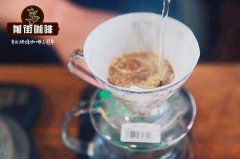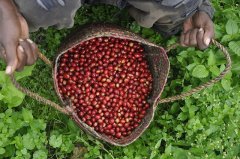Characteristics of Brazilian coffee, introduction of Brazilian coffee yellow bourbon varieties.

Professional coffee knowledge exchange more coffee bean information please follow the coffee workshop (Wechat official account cafe_style)
Of all the coffee producing countries, Brazil has the most advantaged geomorphology and weather conditions, gentle plateau topography, dry and wet seasons, so that the local production is several times higher than that of other countries. In terms of Arabian raw bean production, the average production capacity per hectare can reach 1200 kg (20 large sacks). In addition, the country also invests a lot of research and development funds every year. As a result, the quality and production capacity can continue to rise. At present, the annual output is as high as 45 million to 50 million bags, accounting for 30% of the total global coffee production. It is absolutely an indispensable and important producer in the coffee world. (East African producing countries can produce about 200 to 600 kg per hectare)
The average consumer or business impression of the Brazilian manor stays on the vast expanse of a large manor with thousands of hectares, several stories of raw bean washing equipment and giant harvesting machinery, or a formula filler for the mediocre Espersso. In Taiwan, it is regarded as the base of cheap traditional Mamba recipes, but it is not known that in this vast land of South America, there are actually many very dedicated independent coffee farmers who produce high-quality raw coffee beans year after year, and have repeatedly won very excellent results in the COE Outstanding Cup competition.
Because of the wide variety of Brazilian coffee, we can't just use the word "Brazilian coffee" to include it. The vast majority of Brazilian coffee is unwashed and sun-dried and is classified according to the name of the state of origin and the port of transport. Brazil has 21 states and 17 states produce coffee, but four of them produce the most, accounting for 98% of the country's total output. They are Parana, Sao Paulo, Milas Gerais and Esp í rito Santo. The southern state of Parana has the most astonishing production, accounting for 50% of the total. Although coffee is diverse, Brazilian coffee is suitable for the taste of the public.
Santos, especially Bourbon bour bon Santos (named after the French colonial island of Bourbon bour bon. Bourbon is now known as R é union, where the coffee saplings that brought Para were planted), known for their mellow, flawless and neutral taste.
The three major boutique coffee producing areas in Brazil are Hilado, South Minas and Mojiana in the central and western part of Minas province. The Yellow Wave of Brazil is located in the Hirado region of Brazil. However, not all coffee produced in the prairie of Syracuse can bear the name of Syrador. It is only on the Mesa of the central and western part of Minas Province that the elevation is 1100 to 1300 meters above sea level, and the soil is fertile, so that high-quality coffee with sweet and mellow thickness can be grown.
The general coffee fruit appears red when it is ripe, but the yellow bourbon coffee appears yellow. Compared with other coffee trees, the production of yellow bourbon coffee tree is relatively low and its cultivation is very difficult. Yellow bourbon coffee beans appear bright yellow when they are fully ripe, and the processed roasted coffee beans are dry and sweet with a special nutty aroma. Brazil COE competition over the years many times the top several are led by Huang Bourbon, the flavor is charming.
The so-called bourbon species is native to the island of Reunion in the Indian Ocean. The green fruit appears bright red when ripe.
On the other hand, the yellow bourbon species is a hybrid between the bourbon species and other varieties, and the fruit is yellow when the fruit is ripe.
Because the cultivated yellow bourbon species has low yield and is not resistant to wind and rain, it has not been widely planted. However, when planted at high altitude, it will have excellent flavor performance, which is more common in recent years.
The size of raw beans is slightly smaller, but the appearance is quite good, the appearance is yellowish green and there are very few defective beans.
Brazilian yellow bourbon is treated by half-sun treatment.
Important Notice :
前街咖啡 FrontStreet Coffee has moved to new addredd:
FrontStreet Coffee Address: 315,Donghua East Road,GuangZhou
Tel:020 38364473
- Prev

Guatemala Antigua Coffee production area, Guatemala Flower God Coffee introduction.
Professional coffee knowledge exchange more coffee bean information please follow the coffee workshop (Wechat official account cafe_style) Coffee means "Coffee Flower", this from the center of the volcanic area of Antigua, high-altitude Huasheng coffee, bathed in Antigua's unique micro-geography and climate, by the famous Raminita Manor to provide professional and rigorous planting technology, exhibition
- Next

Kenyan coffee history? What are the relevant coffee institutions in Kenya?
Professional coffee knowledge exchange more coffee bean information please follow the coffee workshop (Wechat official account cafe_style) known as the cup of connoisseurs (Connoisseurs Cup) Kenyan coffee, with rich aroma, bright and vibrant acidity, full and elegant mellow, red wine flavor in the coffee industry famous. Caffeine in different producing areas has different microclimate.
Related
- Detailed explanation of Jadeite planting Land in Panamanian Jadeite Manor introduction to the grading system of Jadeite competitive bidding, Red bid, Green bid and Rose Summer
- Story of Coffee planting in Brenka region of Costa Rica Stonehenge Manor anaerobic heavy honey treatment of flavor mouth
- What's on the barrel of Blue Mountain Coffee beans?
- Can American coffee also pull flowers? How to use hot American style to pull out a good-looking pattern?
- Can you make a cold extract with coffee beans? What is the right proportion for cold-extracted coffee formula?
- Indonesian PWN Gold Mandrine Coffee Origin Features Flavor How to Chong? Mandolin coffee is American.
- A brief introduction to the flavor characteristics of Brazilian yellow bourbon coffee beans
- What is the effect of different water quality on the flavor of cold-extracted coffee? What kind of water is best for brewing coffee?
- Why do you think of Rose Summer whenever you mention Panamanian coffee?
- Introduction to the characteristics of authentic blue mountain coffee bean producing areas? What is the CIB Coffee Authority in Jamaica?

